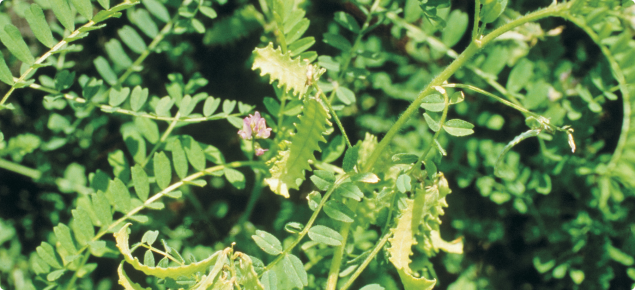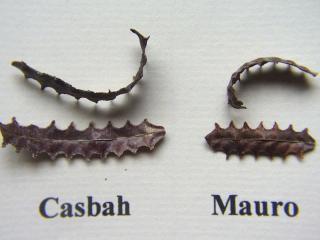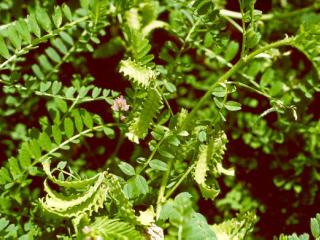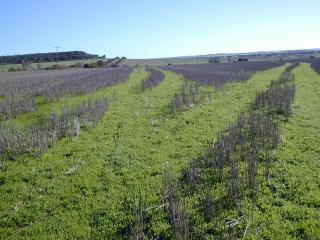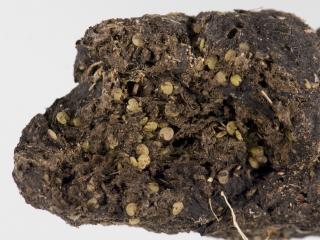Origin
Casbah was collected in Morocco, and Mauro in Sardinia. Casbah was selected by Dr A. Loi, Dr J. Howieson and Dr S. Carr and Mauro was selected by Dr Loi.
Description and area of use
Biserrula has a distinctive fern-like leaves, much like serradella. It is distinguishable by a notch in the top of each leaflet and its pale purple to blue flowers. Pods are flat with serrated edges.
Casbah is a mid-season cultivar, flowering in Perth about 100-105 days after emergence. It is suited to regions with 325-500 millimetres (mm) annual rainfall. Pods of Casbah contain about 20 seeds and individual seeds weigh about 1.2 milligrams (mg).
Mauro is a mid- to late-maturing cultivar, flowering in Perth about 115-120 days after emergence. It is suited to regions with 450-700mm annual rainfall. Pods of Mauro contain about 15 seeds with individual seeds weighing about 1.3mg.
Productivity
Spring herbage yields of biserrula in Western Australia can be as high as 11 tonnes per hectare (t/ha) and compare well with those of French serradella, yellow serradella and subterranean clover. However, herbage production can be reduced by aphid infestation.
Biserrula produces high quality forage in terms of dry matter digestibility, metabolisable energy and crude protein. Levels of crude protein in the vegetative stage are typically around 25% but levels as high as 35% have been recorded, producing high quality stubbles over summer. Biserrula is as tolerant of heavy grazing as subterranean clover but, due to its deep roots, provides green feed for two to four weeks longer than subterranean clover.
Biserrula is a prolific seed producer, with seed yields ranging from 300-1500 kilograms per hectare (kg/ha). Such yields result in high seed numbers because biserrula has a very small seed size (one-sixth the size of subterranean clover). Biserrula has the capacity to set seed under significant grazing pressure.
For example, during 2000, a Casbah pasture at Tincurrin, Western Australia (370mm average annual rainfall; pH 4.5 CaCl2) subjected to a high stocking rate (35 sheep/ha for three weeks from mid-August until mid-September, followed by 12 sheep/ha from mid-October until mid-January) had almost 400kg/ha of residual seed (200kg/ha of which was found in the faecal pellets). The ungrazed (control) plot yielded 1000kg/ha. Because biserrula seeds are so small, about 45% ingested by sheep escape digestion in the rumen. Heavy summer grazing will therefore have little impact on future plant density or long-term persistence.
Persistance
Biserrula has an acid-tolerant rhizobium, which can persist and give excellent nodulation on soils with a pH as low as 4.2 (CaCl2). Biserrula has a deep root system (more than two metres (m) in unrestricted soils), which enables the plant to survive long periods of drought and provides, compared with subterranean clover, an extended period of green feed for grazing animals. Young biserrula seedlings also appear to survive short periods of drought much better than most other temperate annual pasture legume species.
Biserrula’s hardseededness and slow pattern of seed softening make it an ideal legume for ley farming systems. Our studies show that the inclusion of biserrula in the rotation offers several advantages. First, biserrula’s hard seeds tend to germinate towards the end of the summer - autumn period, enabling a large proportion of the seed bank to escape false breaks.
False breaks are the main cause of poor regeneration of subterranean clover pastures. Second, biserrula’s high seed yield and hardseededness allow it to survive in the seed bank for many years. Because of this, high seed production is not required in every pasture year, making biserrula well suited to cropping rotations. Third, many biserrula seeds will survive ingestion so biserrula does not have to be managed as carefully as annual medics during summer grazing.
Casbah has a higher level of hardseededness than Mauro and is better suited to intensive or multiple crop rotations. Casbah should be cropped in the second year. Mauro is better adapted to areas with permanent pasture or less intensive cropping regimes.
Biserrula as a tool to control weeds
Farmers' observations and recent experimental work have shown that the sheep acceptance of Casbah changes during the growing season. Over a short period of time sheep begin to avoid biserrula and preferentially graze the non-legume components of the pasture, rapidly leading to legume dominance. This reduces herbicide resistant weeds such as annual ryegrass and is likely to reduce the use of herbicides in cropping systems.
Research has shown a dramatic reduction in the seed set of annual ryegrass in grazed biserrula pastures compared with burr medic pastures. The reason for this is not clear and is the subject of ongoing research.
Under heavy winter grazing, biserrula adopts a prostrate growth habit that protects it from over-grazing. Biserrula’s high level of hardseededness provides longevity to the seed bank from a single season of production. Spray-topping, which can seriously limit the persistence of softer-seeded species in crop rotations, can be applied to biserrula pastures without jeopardizing long-term persistence (although it will reduce biserrula seed production).
Establishment
As with other pasture legumes, biserrula should be treated as a seed crop in its first season to ensure maximum seed set. Spray-top the paddock in the previous spring or select a paddock coming out of a cereal crop where broad-leaf weeds have been successfully controlled. In high rainfall regions, delay sowing to achieve good weed control with a knockdown herbicide. In low rainfall regions, decrease weed burden in the previous season then sow biserrula as close to the break of season as possible.
Seed of biserrula must be inoculated with its unique inoculant Biserrula Special. Sow biserrula at between 2-10kg/ha, depending on the mixture of pasture legume options available. For optimal establishment sow biserrula less than 2cm deep. This can be accomplished by dropping seed on the surface and covering with trailing harrows. Sow biserrula with 150kg/ha superphosphate or super-potash if on sandy soils.
Control redlegged earth mite until plants have three true leaves. Graze lightly in the first season to allow maximum seed set. For seed crops, inspect for blue-green and cowpea aphid and control if present in large numbers. Crop biserrula in the second year, although good regeneration of Mauro can be achieved by grazing heavily over summer.
Herbicides
There are no registered herbicides for broad-leaf weed control in biserrula. Our research has shown biserrula has particular sensitivity to Broadstrike®, Spinnaker®, Raptor® and MCPA, so weed control before sowing is crucial for the successful establishment of biserrula. Grass weeds can usually be controlled with a selective herbicide. Spray-topping with glyphosate or paraquat can decrease biserrula seed production by up to 85% and is not recommended in the first year of establishment.
Grazing
Photosensitisation
In recent years several outbreaks of photosensitivity have occurred in sheep grazing Casbah biserrula pastures, although the overall incidence was low. In Western Australia, most reported cases of photo-sensitivity have occurred between August and October, the period when spring pasture is green and growing rapidly.
Photosensitivity can arise for a number of reasons and is not peculiar to biserrula. It occurs when photodynamic chemicals in the bloodstream actively sensitise the skin to sunlight. Sunburn-like changes generally occur around the ears, muzzle, tail and backline. The affected areas start to swell and in severe cases the skin can be sloughed off leaving raw sores. Animals are considerably irritated by the condition and will rub affected areas profusely.
Photosensitivity in biserrula is not normally life-threatening. If the condition is picked up early and animals are moved away from sunlight, they normally recover quite well. In severe cases long term scaring can result.
Management
DAFWA is investigating the connection between biserrula and photosensitivity. Current analysis suggests the condition is not a function of liver damage and it is unclear whether the new biserrula cultivar Mauro predisposes sheep to photosensitivity. Until more is known farmers should adopt a cautious approach to the management of sheep grazing biserrula, particularly when this plant makes up a high proportion of the pasture.
Providing an alternative feed source such as hay or straw may be beneficial. Lambs and bare-shorn animals should not be grazed on paddocks where biserrula makes up more than 30% of the pasture. Sheep should be observed regularly for the early signs of photosensitivity including swelling of the ears, eyelids and muzzle and sheep seeking out shade. Suspect animals should be removed from the pasture as soon as any of these signs become evident.
Harvesting
Harvesting biserrula with a grain harvester is possible, but major modifications to the drum are required. Biserrula is generally successfully harvested with specialist suction harvesting equipment (600-800 kg/ha of seed).
Production and marketing
Casbah is a public variety and can be freely bought and sold. Mauro is protected under the Plant Breeders Rights Act 1994 .

